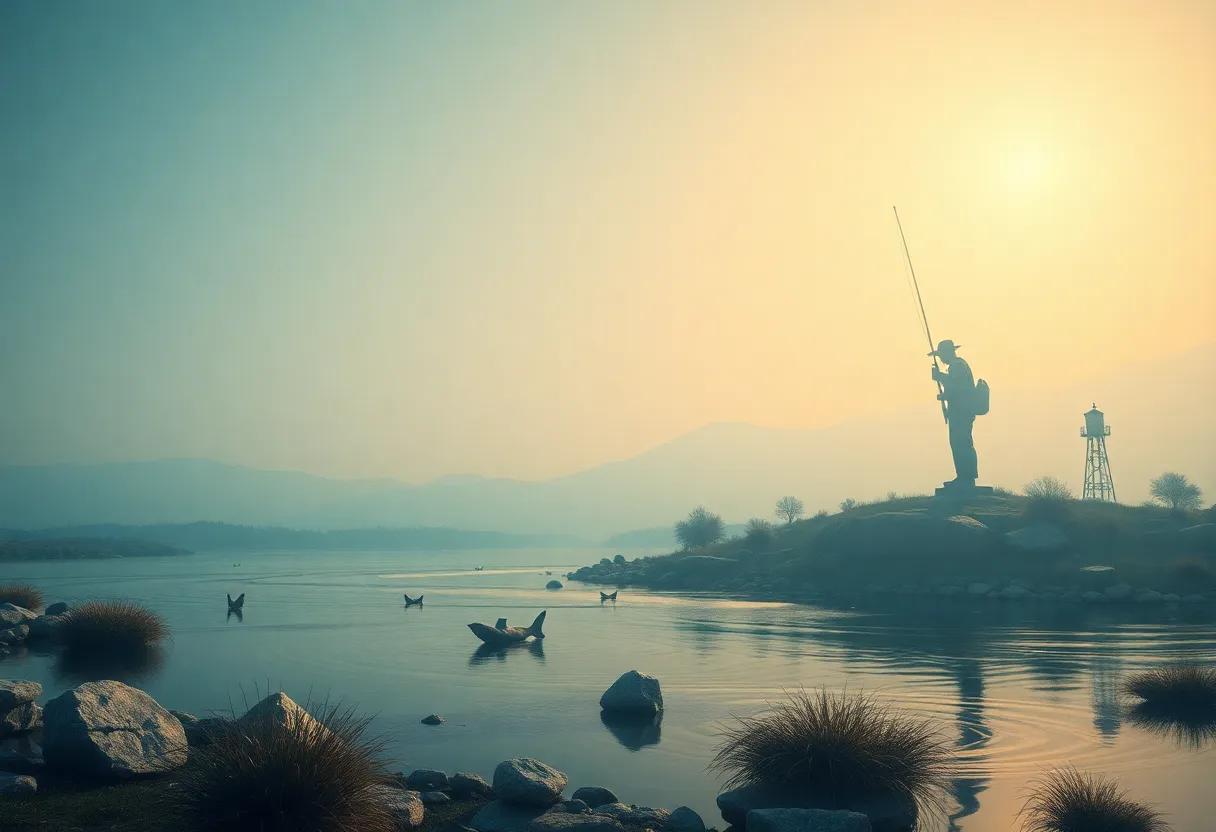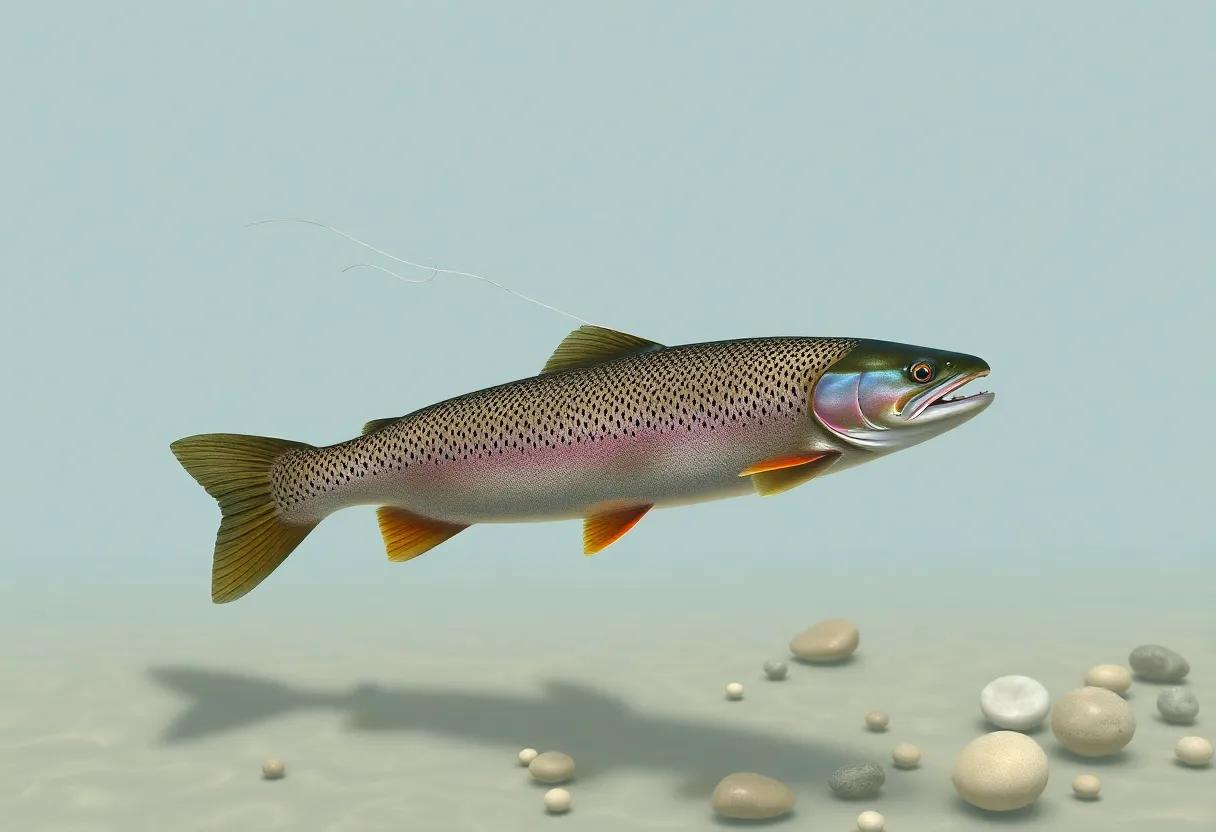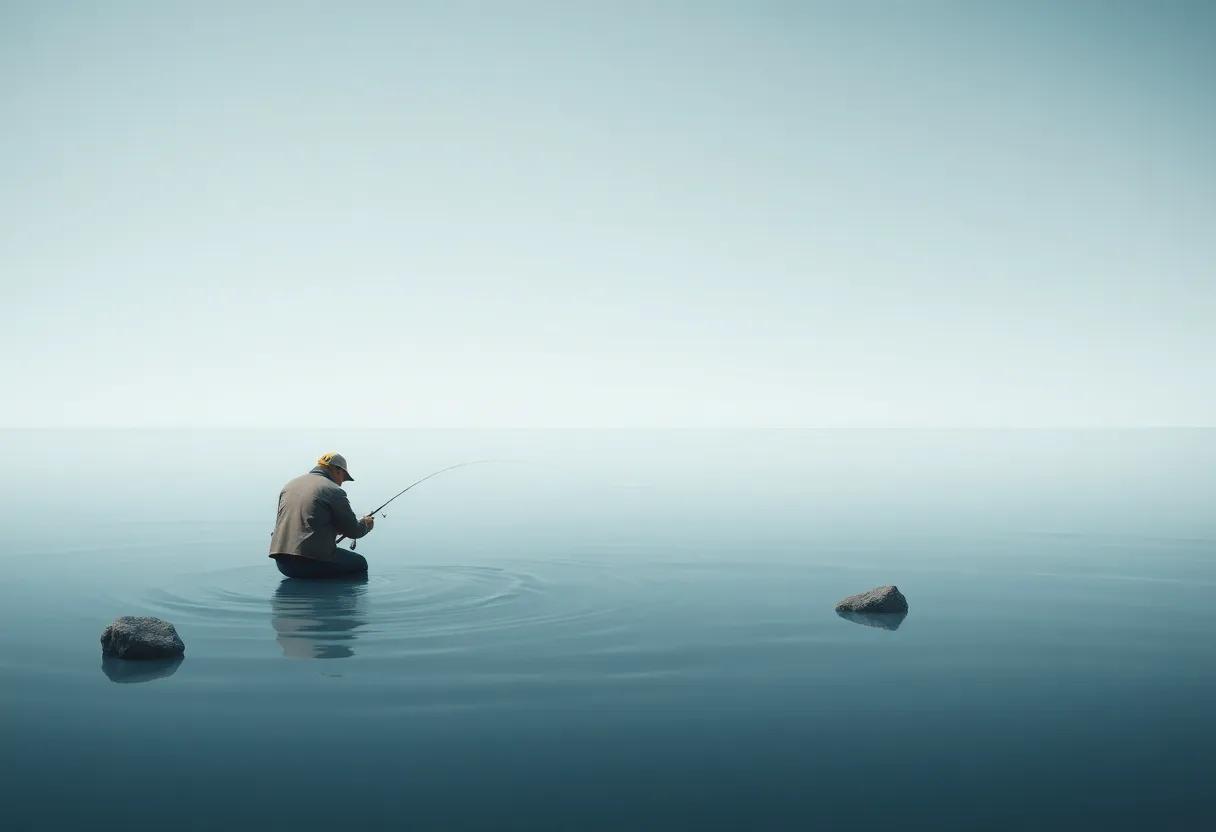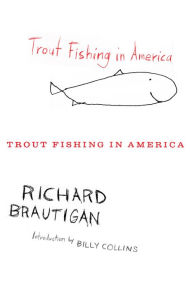In the vast, flowing currents of American literature, few works shimmer with as much whimsical charm and elusive depth as Richard Brautigan’s Trout Fishing in America. invites readers to cast their lines once more into this peculiar river of prose,offering a fresh perspective that wades gently through the book’s surreal episodes and poetic murmurings. This review navigates the reflective waters of Reeling in Reality, exploring how it captures Brautigan’s distinctive blend of humor, nostalgia, and philosophical musing-ultimately questioning what it means to seek truth in a landscape as fluid and unpredictable as the one Brautigan paints.
Exploring the Surreal Landscape of Brautigan’s narrative Voice and Its Impact on Modern American Literature

The ripple effects of Brautigan’s narrative style ripple far beyond his own pages, influencing a generation of writers who embrace fragmentation, non-linear storytelling, and a quirky, intimate tone. Modern American literature often borrows from his toolkit:
- Playful ambiguity: Encouraging readers to piece together meaning.
- Interweaving personal and collective histories: blurring autobiography and myth.
- Minimalist yet evocative imagery: Painting vivid scenes with few words.
To put it succinctly, brautigan’s work functions almost like a poetic wilderness where readers lose themselves, yet find reflections of both their own realities and the collective zeitgeist. This fusion of the surreal with the intimate continues to shape contemporary narrative experimentation, ensuring his voice remains an echo in the halls of literary innovation.
Unpacking the Symbolism Behind Trout Fishing as a Metaphor for Existential Reflection and Cultural Commentary

In Brautigan’s work, trout fishing transcends its pastoral roots, becoming a vessel through which deeper existential musings are cast. The act of fishing – patient, solitary, unpredictable - mirrors the human confrontation with life’s inherent uncertainties.Each cast is an attempt to engage with the unknown, a metaphor for grappling with identity, purpose, and the elusive nature of fulfillment. This quiet struggle, set against the serene yet indifferent backdrop of nature, invites readers to contemplate not just the external habitat but the internal currents shaping self-awareness and meaning.
Beyond individual introspection, trout fishing embodies cultural critique, subtly unpacking the postmodern tension between tradition and modernity. Its symbolism reveals:
- The commodification of nature - highlighting how modern society frequently enough detaches, packaging primal experiences into consumable leisure.
- Ephemeral connections – suggesting that human relationships,much like the fleeting catch,are transient and enigmatic.
- Resistance to conformity – where the quiet rebellion of fishing becomes an allegory for preserving individuality amid homogenizing forces.
| Symbol | Interpretation | Cultural Resonance |
|---|---|---|
| Fishing Line | Fragility of human hopes | Delicate balance between control and surrender |
| Trout | Escape and elusiveness | Desire for freedom within societal constraints |
| Water | Unconscious mind | Depths of personal and collective memory |
A Closer Look at the Fragmented Structure and how It Enhances the Reader’s Immersive Experience
Rather than following a conventional narrative arc, Brautigan’s work embraces a mosaic of brief, seemingly unrelated vignettes that challenge the reader’s expectations. This fragmented structure mirrors the elusive nature of memory itself, where moments flash in and out without clear connection, yet collectively form a vivid emotional landscape. Each segment acts as a separate thread in an intricate tapestry-sometiems whimsical, sometimes profound-that invites readers to piece together meaning on their own terms. By disrupting linear storytelling, Brautigan crafts an experience that feels both intimate and spontaneous, allowing readers to linger in the nuances of each snapshot without the pressure of arriving at a definitive conclusion.
- Non-linear progression: Encourages active reader participation
- shifting perspectives: Offers a kaleidoscopic view of American life
- Fragmented vignettes: Evoke the fluidity and unpredictability of thought
To visualize how the fragments interlock, consider this simple breakdown of narrative qualities and their effects:
| Fragment Type | Effect on Reader | Example Mood |
|---|---|---|
| Whimsical Anecdotes | light-hearted curiosity | Playful |
| Philosophical Reflections | Deep contemplation | Thoughtful |
| Surreal Imagery | Heightened imagination | dreamlike |
This patchwork design not only evokes the fragmented nature of reality but also plants the reader firmly within Brautigan’s poetic mindset, fostering an immersive experience where meaning fluctuates and personal interpretation reigns supreme.
Delving into Themes of Nostalgia, Nature, and Urban Disconnection in Brautigan’s Poetic Prose
Yet,amid this pastoral reverie lies a stark undercurrent of urban disconnection. Brautigan subtly critiques the alienation that modern life imposes, where concrete jungles replace actual ones and human relationships feel as fragmented as the city sidewalks. Through a tapestry of seemingly whimsical vignettes, the reader confronts the uneasy tension between the organic and the artificial, the remembered and the immediate. This tension is beautifully captured in the following contrasts:
- Flowing rivers vs. cold, lifeless streets
- free-roaming fish vs. confined urban routines
- Natural rhythms vs. mechanical clocks
| Theme | Representation in Nature | Urban Parallel |
|---|---|---|
| Nostalgia | Rippling creek reflections | faded photographs |
| Connection | Fishing in quiet solitude | Anonymous crowds |
| Dislocation | Barren riverbeds | Empty subway stations |
Analyzing the Balance Between Humor and Melancholy in Shaping the Book’s Unique Emotional Tone

brautigan masterfully threads a delicate fabric woven from both laughter and sighs, crafting an emotional tapestry that refuses to be pinned down by a single mood. his humor is not the raucous kind that demands uproarious laughter but rather a subtle, almost mischievous playfulness that invites the reader to linger in the absurdity of life’s small moments. This lightheartedness serves as a gentle buffer against the undercurrents of melancholy that ripple throughout the narrative-an elegiac reflection on memory,loss,and the elusive nature of happiness. The balance is carefully calibrated, making it unfeasible to find one without the other, generating a bittersweet aftertaste that stays with the reader long after the final page.
- Humor: reflective irony, whimsical scenarios, understated wit
- Melancholy: nostalgic longing, moments of isolation, subtle grief
This interplay shapes the book’s unique emotional cadence, like a softly rocking boat navigating between calm and storm. Consider the way brautigan’s prose meanders-sparse yet evocative, playful yet weighted-mirroring the emotional seesaw embedded within the stories themselves. The following table highlights key emotional elements Brautigan employs and their impact on the reader’s experience:
| Emotional Element | Stylistic Feature | Reader’s Response |
|---|---|---|
| Playful absurdity | Unexpected juxtapositions | Amusement mixed with curiosity |
| Quiet nostalgia | Simple yet poignant imagery | Subtle sadness and introspection |
| Gentle irony | Understated humor with depth | Reflective engagement |
The Role of Minimalism and Whimsy in Crafting Brautigan’s Distinctive Literary Style
Brautigan’s narrative charm lies in his ability to juxtapose spare, minimalist prose with a buoyant sense of whimsy that illuminates the mundane.This pairing creates a literary rhythm that feels simultaneously stripped-back and richly textured, encouraging readers to engage with each line as both a fragment of reality and a playful twist on it. His sentences often feel like fleeting snapshots,brief yet saturated with a gentle absurdity that resists heavy-handed interpretation.Such a style invites readers to float beneath the surface of narrative convention, discovering meaning not through exposition but through suggestion and the unexpected detours of imagination.
The subtle dance between restraint and eccentricity in his work can be broken down into key elements that continually shape his voice:
- Economy of Language: concise, pared-down sentences that leave space for reader introspection.
- Playful Imagery: odd, surreal moments that punctuate otherwise straightforward storytelling.
- Nonlinear Progression: a narrative flow that mimics the randomness of memory and thought.
- Understated Emotion: feelings conveyed with a gentle touch, often filtered through whimsy.
Together, thes techniques forge a unique aesthetic, one that embraces imperfection and the beauty of the everyday, while inviting a smile at the eccentricities woven in between.
| Element | Effect on Style |
|---|---|
| Minimalism | Amplifies subtlety, fosters openness |
| Whimsy | Injects humor and surreal surprise |
| Nonlinear Structure | Mirrors natural thought patterns |
| Understated Emotion | Elicits quiet, resonant feelings |
How Reeling in Reality Challenges Traditional Storytelling Through Experimental Narrative Techniques
Brautigan’s work deftly abandons the conventional linear progression found in traditional storytelling, opting instead for a mosaic of vignettes, poems, and prose fragments that challenge readers to piece meaning from an intentionally disjointed narrative. This fragmentation not only reflects the chaotic nature of memory and perception but also invites a more active engagement, where interpretation becomes as fluid and playful as the text itself. the narrative’s refusal to conform to a single voice or chronology underscores a bold experimentation with form, pushing the boundaries of how stories can be told and experienced.
Key experimental techniques in this approach include:
- Non-linear sequencing that disrupts temporal expectations
- Blurring of genres, blending poetry and prose seamlessly
- Use of repetition and variation to create thematic resonance
- Minimalistic description paired with evocative imagery
| Technique | Impact | Example |
|---|---|---|
| Fragmented narrative | Engages reader interpretation | Separated anecdotes |
| Genre Blending | Challenges categorization | Poetry within prose |
| Repetition | Builds rhythm and theme | Recurring trout imagery |
By rewriting the rules of storytelling, Brautigan’s text serves as a reminder that narrative can transcend the familiar frameworks, embracing ambiguity and abstraction as tools rather than obstacles. This playful experimentation captures the essence of reality in its imperfect, fragmented beauty, thus reshaping the reader’s expectations and redefining the very nature of literary engagement.
Recommendations for Readers Seeking a thought-Provoking Yet Accessible Exploration of 1960s Counterculture
To enhance your reading journey, consider pairing Brautigan’s novel with these complementary approaches:
- Explore Spoken Word and Beat Poetry: Dive into contemporary performances that echo the book’s whimsical yet incisive tone.
- Engage with Visual Art from the Era: The fusion of psychedelic posters and pop art offers a vivid backdrop to Brautigan’s narrative style.
- reflect through Journaling: Document your personal reactions and insights after each chapter to uncover your own countercultural connections.
| Theme | Atmosphere | Suggested activity |
|---|---|---|
| freedom & Rebellion | Lighthearted & Reflective | Creative Writing |
| Nature & Surrealism | Dreamlike & Playful | Outdoor Walks with Observation |
| Community & Individuality | Warm & Quirky | Group Discussions |
Comparative insights: Positioning Trout Fishing in America Within the Beat Generation and Postmodern Movements
Trout Fishing in America is a literary chameleon that straddles the edges of both the Beat Generation’s freewheeling spirit and the Postmodern penchant for fragmentation and playfulness. Like the Beats, Brautigan embraces an unfiltered, almost spontaneous prose style that mirrors the countercultural quest for authenticity and escape from societal rigidity. Yet, unlike the often raw and impassioned narratives of Kerouac or Ginsberg, brautigan’s work leans into whimsy and whimsical non-sequiturs, inviting readers to experience the absurdity of the American Dream through a lens tinted by surreal detachment. His poetic jiggles between anecdote and metaphor reflect a Beat inclination toward personal exploration but with an undercurrent of postmodern irony that questions the very act of storytelling itself.
The novel can be positioned at a fascinating crossroads where traditional narrative dissolves into episodic fragments, echoing postmodern literature’s rejection of grand overarching plots.This interplay is captured in the table below, illustrating key attributes of both movements as reflected in Trout Fishing in America:
| Aspect | Beat Generation | Postmodernism |
|---|---|---|
| Style | Spontaneous, poetic, raw | Fragmented, playful, ironic |
| themes | Freedom, rebellion, searching | Absurdity, metafiction, pastiche |
| Approach to Reality | Direct confrontation | Distorted reflection |
| Narrative Structure | Linear with digressions | Non-linear, decentralized |
- Fluid identity: Brautigan’s narrator slips between observer and participant, echoing postmodern self-awareness while nodding to the Beat celebration of the individual.
- Language play: The prose dances on the edge of clarity, capturing both the Beat love for poetic spontaneity and postmodern irony.
- Cultural critique: Both movements disrupt mainstream American values, but brautigan’s subtle humor offers a less confrontational, more reflective critique.
The Influence of Brautigan’s Own Life Experiences Reflected Through His Semi-Autobiographical Elements
Richard Brautigan’s Trout Fishing in America is not merely a whimsical collection of surreal vignettes; it functions as a kaleidoscopic mirror reflecting fragments of his own life. His experiences are distilled into a form that blends reality with imagination, revealing the *textures* of his existence through semi-autobiographical elements. Brautigan’s upbringing in the pacific Northwest, his immersion in counterculture, and his complex relationships subtly surface in the text, crafting a narrative that is as much about internal states as it is indeed about external events. The book’s fragmented style mirrors Brautigan’s own restless spirit, suggesting a life that resists neat categorization. This allows readers to connect intimately with the man behind the myth, as his personal struggles and joys trickle through the prose in moments of melancholy, humor, and understated rebellion.
Through an array of recurring symbols and motifs, Brautigan invites the audience to piece together his lived reality from the abstract. From the elusive act of fishing-which simultaneously embodies pursuit, patience, and the absurdity of life-to his nostalgic view of american landscapes, the narrative becomes a vessel filled with layers of meaning tied to his identity. Key semi-autobiographical themes include:
- Disconnect and alienation: Experiences of social estrangement amidst 1960s America.
- Nature as refuge and metaphor: The Pacific Northwest’s influence on his worldview and literary imagery.
- Humor intertwined with melancholia: Coping mechanisms woven into his storytelling.
- Nonconformity and counterculture: Reflections of his participation in and skepticism toward mainstream culture.
| Life Event | Reflection in the Narrative |
|---|---|
| Early childhood in the Pacific Northwest | Evocative description of rivers, forests, and natural settings |
| Involvement in countercultural circles | Playful, subversive tone and rejection of traditional narrative form |
| Personal relationships and solitude | Moments of intimacy juxtaposed with existential isolation |
Assessing the Lasting Legacy and Cultural significance of Trout Fishing in America in Contemporary Literary Circles
Trout fishing, as immortalized in Richard Brautigan’s Trout Fishing in America, transcends its literal pastime to become a metaphorical reservoir for contemporary writers and readers alike. Within literary circles, Brautigan’s work is revered not just for its quirky narrative style but for how it captures a uniquely American ethos-one that mixes whimsy with existential reflection. This fusion has inspired a lineage of authors who delve into nature, nostalgia, and absurdity, weaving these elements into their storytelling to explore identity, freedom, and cultural memory. the cultural dialogue sparked by Brautigan’s prose can be traced in modern creative works that treat fishing as both a physical act and a symbolic quest, bridging generational gaps while challenging traditional literary forms.
Key influences in contemporary literary circles include:
- Experimental narrative structures that blur reality and fantasy
- Use of nature as a setting for introspective and philosophical inquiry
- The pursuit of American individualism through minimalist prose
- Reclamation of rural and environmental themes in urbanized cultures
| Element | Literary Impact |
|---|---|
| Symbolism of Trout | Freedom, escape, and fleeting beauty |
| Humor | Disarming tone highlights absurdities of life |
| Fragmented storytelling | Reflects modernist influences and postmodern playfulness |
| Environmental Awareness | Early nods to ecological consciousness in literature |
This enduring cultural significance extends beyond literature into broader symbolic realms, where trout fishing signifies an intimate connection to nature and a quiet rebellion against homogenization. Brautigan’s influence encourages writers to explore the liminal spaces between tradition and innovation, embedding their works with a subtle wisdom that continues to resonate in America’s evolving literary landscape.
Suggestions for Further Reading to Deepen Understanding of Brautigan’s Artistic and Philosophical Vision
To truly immerse yourself in the quirky, enigmatic world that Richard Brautigan crafts in Trout Fishing in America, delving into his lesser-known essays and poetry collections can be invaluable. Works such as “The Pill Versus the Springhill Mine Disaster” and “Revenge of the Lawn” reveal the evolution of his surrealist voice and recurring motifs of nature interlaced with absurdity. Complementing these with critical essays on American counterculture offers a broader context for his playful anarchism and deep philosophical questioning, bridging the gap between whimsy and profound insight.
For a more structured exploration, the following table outlines significant companion texts and critical perspectives that illuminate Brautigan’s artistic vision and the past milieu influencing his style:
| Title | Author | Focus |
|---|---|---|
| City Lights and Counterculture | Walter Sterling | Beat Generation and San francisco Poet Scene |
| Surrealism in American Literature | Isabel Ramirez | Surrealist Techniques and Influence |
| Nature and Absurdity | Julian McKee | Philosophical Readings of Brautigan’s Nature Imagery |
About the Reviewer and Their Background in Literary Criticism and American Countercultural Studies
With over a decade immersed in literary criticism and an academic focus on American countercultural movements, the reviewer brings a nuanced perspective that balances scholarly rigor with an gratitude for experimental prose. Their journey began in the halls of a liberal arts college, where courses on beat writers and the 1960s cultural upheaval kindled a captivation with authors who subverted conventional narrative forms. This foundation was later enriched by postgraduate research that examined the intersections between cultural identity and literary innovation, with particular attention to voices that challenged the mainstream American ethos.
Beyond academia,the reviewer is an avid participant in contemporary literary forums and workshops dedicated to exploring option storytelling techniques. Their engagement extends to curating reading groups centered around dystopian, surreal, and anti-establishment texts, fostering dynamic dialogues that reveal the layered significance of such works. The following list highlights key areas of expertise that shape their analytical lenses:
- Mid-20th-century American counterculture and its literary manifestations
- Postmodern narrative structures and fragmentation
- Intertextuality and metafiction in experimental prose
- Socio-political critiques embedded in avant-garde literature
| Expertise Area | Years of Focus | Representative Work |
|---|---|---|
| American Countercultural Literature | 12 | Study on Beat Writers |
| Postmodernism | 8 | Fragmentation & Form Analysis |
| Meta-narrative Studies | 6 | Intertextuality in Modern Fiction |
| Sociopolitical Literary Critique | 10 | Avant-garde as Social Commentary |
In navigating the winding currents of , readers are invited to cast their lines into a stream where reality and imagination mingle with effortless grace. This review has sought to untangle the layers of Brautigan’s whimsical narrative and the author’s interpretive lens,illuminating the myriad ways the text challenges conventional storytelling. Whether you come fishing for nostalgia, philosophy, or simply a quirky literary ride, this reflective dive promises to leave you thinking long after the last page is turned-much like the gentle ripple of a trout’s tail breaking a still, quiet surface.











